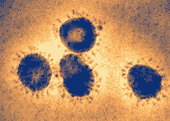Spinning the Wheels
China did not agree. The Ministry of Health on March 17 for the first time gave WHO a brief report on the Guangdong outbreak of what it still called atypical pneumonia. The report yet again stated that the outbreak had tapered off. In Bekedam’s view, the timing of the National People’s Congress, which had just wrapped up on March 14, contributed to China’s official silence and lack of engagement to date. “Things started moving rapidly in Beijing only after the new government took office,” confirms Schnur.
Coronavirus . On March 19, MoH sent WHO a letter saying that researchers had found chlamydia in five atypical pneumonia patients. But the next day, scientists in Singapore identified coronavirus-like particles in samples from three SARS patients. On March 20, WHO provided a clinical picture of SARS based on the findings from patients in seven countries, as well as advice on the discharge and follow-up of SARS cases. On March 22, researchers in both Hong Kong and the US confirmed Singapore’s finding that a coronavirus—a family of diseases that causes, among other ailments, the common cold—was the likely cause of SARS.

Coronavirus
As it happened, both Chinese Minister of Health Zhang and WHO Regional Director Omi were in Hong Kong on March 22 for a public health event. The two met separately to discuss the SARS outbreak. The meeting was tense: Omi pressed for more information and access to Guangdong; the minister asserted that WHO had all the information China did. Through back channels, the ministry had in fact supplied information on the number of atypical pneumonia cases in China. But the information China had provided was insufficient—the world had moved well beyond numbers to needing to understand how the disease began, how it spread, and how to contain it. WHO needed answers from patients to such basic questions as: Where were you yesterday? What did you do? Where did you go? Whom did you meet? “If we would have known who had been infecting whom, it could have at least helped us,” says Bekedam.
Mission #2 . However, WHO persevered. Armed with the March 13 assurance from Minister Zhang that a mission could visit Guangdong, WHO on March 23 dispatched a second team to Beijing. In an encouraging sign, China relaxed its visa requirements, and the team arrived on short notice, intending to work in Beijing while awaiting permission to travel to Guangdong. It never came. “We thought we’d get permission,” recalls Schnur. “We didn’t fully understand that there was so much objection to putting people out in the field.”
Between March 24 and 28, the team met several times with MoH staff in Beijing. The group was dismayed by the startling gaps in knowledge it encountered among the Chinese officials. On a positive note, China on Wednesday, March 26, issued its first list of atypical pneumonia cases since February 11: 792 cases (with 31 deaths) in Guangdong from November 16, 2002 through February 28, 2003. On Thursday, March 27, it added Beijing to the list of affected areas, reporting three deaths and five suspected cases (it also added Shanxi province). It was the first admission by China that the disease had spread to the capital. [20]
In another breakthrough, the Chinese finally agreed that the Guangdong cases were SARS. On March 27, the mission was finally able to meet with CCDC technical officers. After the Chinese presented their epidemiological data, Schnur commented: “It seems that if we look at your case definition, your symptoms—all that seems to match the ones found in Vietnam and Hong Kong. Can we agree that these are SARS cases?” They all nodded. The next morning, Bekedam met with officials at the Ministry of Health to update them on the WHO mission before the scheduled end-of-mission press conference. He noted that “our technical people agree with your technical people that these are SARS cases. Do you agree with that?” Again, the answer was yes. Bekedam issued a statement: “This week, China has become, very clearly, part of the global network in dealing with the disease.” [21]
The ministry also promised that starting April 1, it would provide WHO with regular, up-to-date reports on SARS cases from all provinces. By that point, says Bekedam, it was becoming clear that the Communist Party was starting to take over responsibility for SARS from the government. “The minister of health tried in his way to get information in the months of February and March, but he was unable to get it,” recalls Bekedam.
By the end of March, WHO had reports of some 1,408 suspected SARS cases in 12 countries and 14 geographic areas, plus 51 in the US. That included 53 deaths—or a 4 percent mortality rate. [22] On March 29, the US government issued travel advisories for China, Hanoi, Singapore and Hong Kong. WHO had already recommended that travelers from outbreak areas be screened for SARS symptoms.
[20] CNN Health, “China says 34 killed by virus,” March 27, 2003. See: http://articles.cnn.com/2003-03-26/health/singapore.sars_1_sars-cases-severe-acute-respiratory-syndrome-virus?_s=PM:HEALTH
[21] WHO, SARS , p.24.
[22] CNN Health, “Mystery illness spreads,” March 28, 2003. See: http://articles.cnn.com/2003-03-27/health/mystery.illness_1_mystery-illness-coronavirus-sars-patients?_s=PM:HEALTH